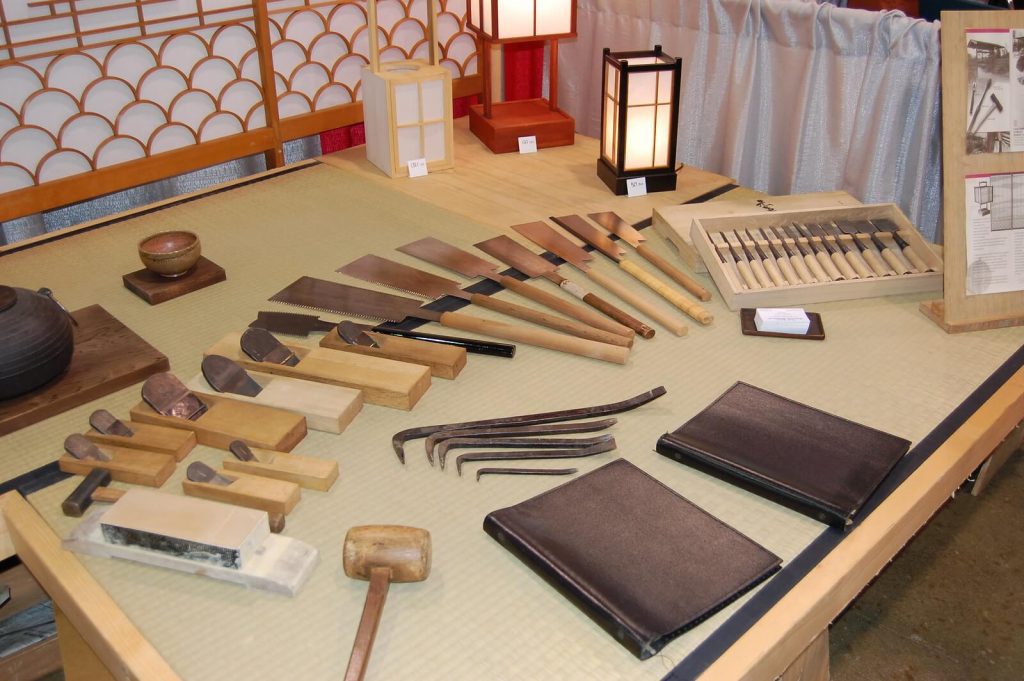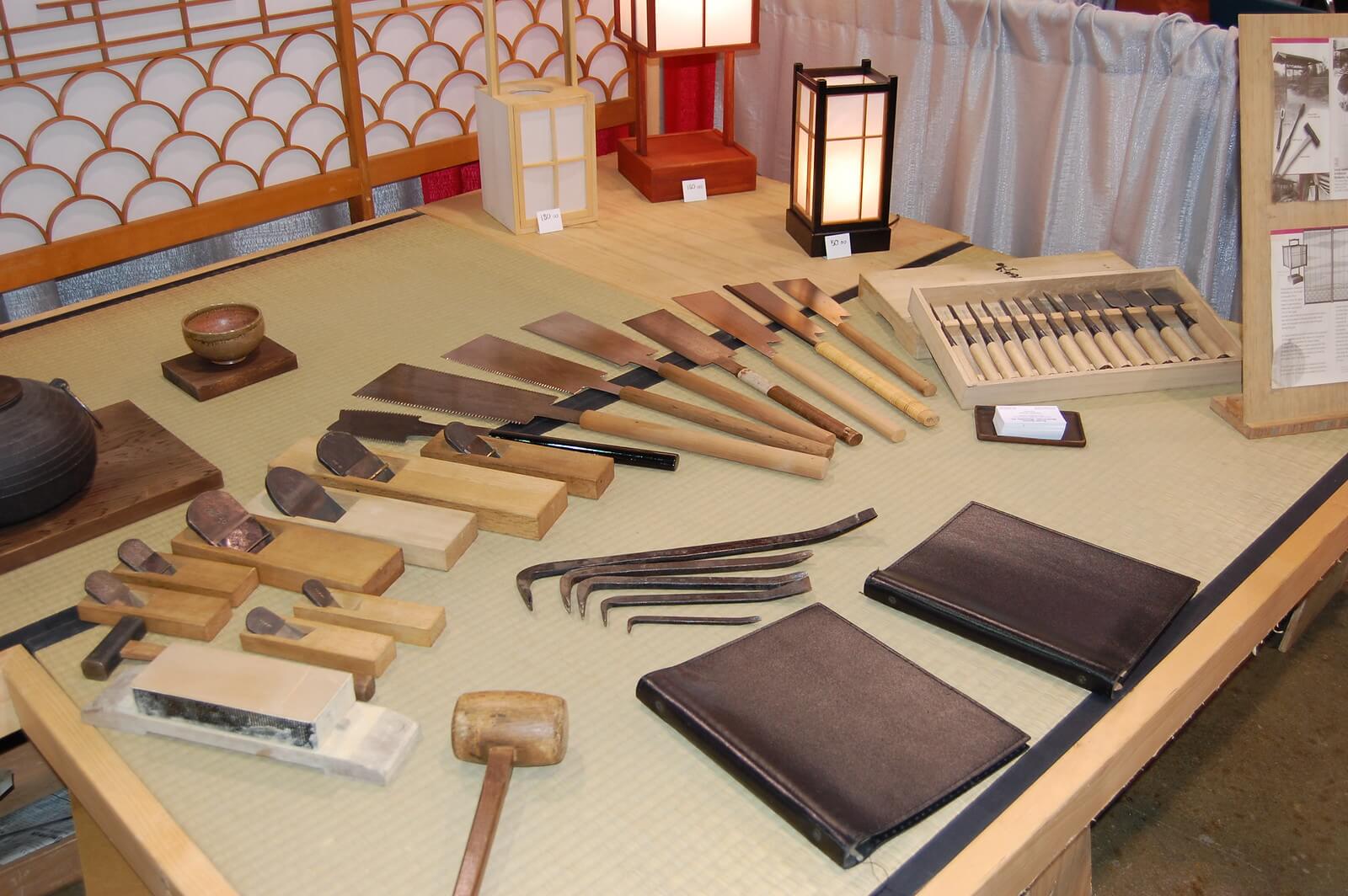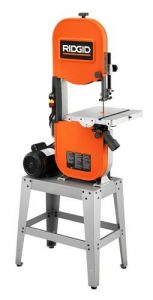Traditional Japanese woodworking is in a class all its own, considerably different than the woodworking of other cultures. The artistic nature of their carving and joinery reflects the nature of the culture it comes from. But much of the defining characteristics of Japanese woodworking and especially their intricate method of joinery is based upon practical necessity, not artistic expression.
Japanese carpenters constantly had to deal with two serious shortages: that of wood and that of iron. The three main islands of their country are largely mountainous, originally formed by volcanoes in times past. This left them with little wood to use for beams in their temples and walls in their homes.
Japanese carpenters were up to the challenge, developing the traditional wood framed paper panels that make up the traditional home’s walls and doors. This allowed for construction with a minimal of material, while still allowing the home to provide some element of privacy. Coupled with the traditional Japanese sense of politeness, people were able to live their lives comfortably in those paper homes.
The lack of iron for fasteners led to Japanese carpenters developing some of the most complex joinery in the world. Much of it has hidden elements, like mortises and tenons, which can only be seen when the joint is taken apart. Various pins held these joints together while the other elements of the joint carried the load.
The many temples throughout Japan are largely made of wood, with complex joinery for assembly of beams and structure. In many cases, beam sections had to be hand-cut from more than one log, and then joined together in such a way as to be strong enough for the intended span, without sagging or breaking. Obviously a finger-joint isn’t enough to support that much weight, nor is a dovetail. The Japanese carpenters had to be very creative in developing joints which would work, complicated by the fact that the joints were supposed to be nearly invisible.
The art of Japanese woodworking has not been lost through the years. Typically, Japanese temples last for 150 to 200 years, before they need to be rebuilt. Considering that some of those are more than 2,000 years old, they have been rebuilt many times over, with skilled craftsmen replicating the original design down to the smallest detail. These carpenters are probably some of the finest in the world, especially when it comes to complex joinery.
Making a joint that precise requires tools which are designed for precision. This requirement, coupled with the Japanese history of finely crafted blades, has resulted in some of the finest hand tools ever made. While we can recognize many of these tools as being similar to those we are accustomed to using, there are some distinct differences that are well worth noting.
Japanese Saws
Perhaps the most interesting of all Japanese hand tools are Japanese saws. Rather than being a push saw, like those we use here in the west, they are a pull saw. This small but important distinction totally transforms how one works with these tools.
To start with, being pull saws allows for the saws to be made of thinner metal, as the metal doesn’t have to be able to stand up under the stress of being pushed through the wood, cutting, without flexing. Pulling the saw through the material makes it much easier to make an accurate cut, an essential for Japanese joinery. The teeth are also ground differently, allowing Japanese saws to make very aggressive cuts, slicing through a board much faster than western push saws can.
The most iconic Japanese saw is the Ryoba. This is a double sided saw, with a blade that grows wider towards the tip. One side of the blade has finer teeth than the other, providing a rip blade and a crosscut blade in the same saw. This is a general-purpose saw, used for everything from resawing to cutting tenons into wood.
While you can use a Ryoba for ripping, even resawing a board, carpenters who are making a deep cut will often switch over to the Kataba. This is a single-sided blade, with teeth for crosscutting. By eliminating the second set of teeth, this blade allows for a smoother finish to the cut, as the second blade on the Ryoba will scar the surface of the cut, much like a circular saw blade does.
For more precise work, there is the Dozuki. This is much like the Kataba, with a stiffener along the back side of the blade, much like a western back saw. The stiffener helps to keep the blade straight, preventing the vibration that can happen while cutting.
This blade is predominantly used for cutting the shoulder of tenons and dovetails. It is the true secret to the complex dual-angle dovetails which are a hallmark of finer Japanese woodworking. The stiffer blade allows for precise cutting of those dovetails, with little to no need to clean up the cut with a chisel. In many cases, the dovetails are so narrow, that there isn’t enough room to put a chisel in there anyway.
I’ve used Japanese hand saws for years, having long ago replaced my more traditional push saws with them. To be honest with you, I never got the hang of cutting accurately with a push saw; my cuts were always crooked, with the end of the board either angled one way or the other. That was what motivated me to switch over to pull saws, a change I’ve never regretted.
Japanese Planes
Like Japanese saws, Japanese planes are designed to be pulled towards the woodworker, not pushed away from the woodworker, like a western plane. As best I know, they are only available as wood-bodied planes, with nobody producing cast-iron plane bodies.
As with the saws, the pulling action allows for excellent control of the plane. However, the lack of any handles on the plane body requires a little getting used to. In order to pull the plane through the wood, one hand is cupped behind the blade, while the other grasps the front part of the plane body. A good grip is clearly needed to overcome the wood’s resistance to the plane. But the plane is able to produce an extremely fine cut, with shavings the full size of the board’s face and thin enough to read through.
The blade on Japanese planes is thicker than western planes and made of two different metals. The added thickness serves a purpose, in lowering the overall chatter the blade can produce. That chatter can translate directly to waviness in the finished surface of the wood, so it is something worth considering. The forged bi-metal blade allows for a stiffer layer for strength, along with a softer layer which is easier to sharpen.
Do not expect any Japanese plane to be ready to use right out of the box. You’ll need to sand the sole, flattening it, as well as sharpening the blade. Unlike western style planes, the blade does not have a finished edge, shipped that way under the belief that the true craftsman will want to sharpen it to their preferences.
Deciding which is better for you is more a matter of preference than anything else. Both styles of tools will do the work, with some people finding a push plane easier to work with while others find a pull plane easier to work with.
Japanese Chisels
The Japanese use a wide variety of chisels in their woodworking, especially for the complex joinery that they do. Even so, one could easily think that chisels are chisels and there really wouldn’t be much difference between Japanese chisels and western chisels. But there are differences and they are significant.
These differences are in the blades, more than anything else. Japanese chisel blades are boxier and heavier than those of western chisels. The added metal required for this design tends to make the chisels more expensive. They also come in sets with many more widths than typical western chisels, as they are intended for use in Japanese joinery, where there is a need to have a chisel that is the width of the dovetail or finger being cut out. These blades are always in metric widths.
The steel used in Japanese chisels is also considerably harder than that used in western chisels. They sharpen to an incredibly sharp edge, which is necessary for Japanese joinery, and tend to hold that edge well. But as with any hard steel, the steel used in these chisels can be prone to chipping, if they are not used with care.
The blade is also mated to the handle differently than with western chisels, using a long tang, which goes into a hole in the wood handle. This provides excellent mating between the blade and handle, a necessity for hammering the chisel. Since these chisels are often used with a hammer, this is an important consideration.
Basically, western chisels are designed for clean-up and rough work. They are excellent for cleaning up the inside of a dovetail cut, when the cut wasn’t made right to the line. Another place where they shine is when hogging out large amounts of material, such as making a half-lap, where the chisel needs to be able to enter well into the wood and split it. While that can be done with a Japanese chisel, the thicker blade is likely to cause the wood to split in an inappropriate way.
Where the Japanese chisel shines is when you have to cut out a mortise or make the cut at the base of a dovetail joint. The hard, sharp blade cuts well in those circumstances, and the overall design of the chisel is perfect for pounding the blade through the wood, without any risk of damage to the chisel.
Speaking of cutting mortises, while normal Japanese chisels can be used for cutting a mortise, they also have specialty mortise chisels. These do not have bevels on the sides of the blade, but have a square cross-section. They are used only on the first part of cutting the mortise, where the straight sides help in making sure that the mortise is straight.

Japanese Dovetail Chisels
Since fancy dovetail joints are a major part of Japanese woodworking, it’s not surprising that they have specialty chisels, just for cutting dovetails. The main difference in these chisels and any other Japanese chisels is that the longitudinal bevels on the top of the chisel are ground at a shallower angle, helping to ensure that the body of the chisel’s blade doesn’t run into the sides of the dovetail when using it.
As with normal Japanese chisels, these typically come in a set. Other than the angle of that bevel, they are made in the same way as other Japanese chisels, making them ideal for being driven through the wood by a hammer, making a clean cut.
There is also a specialty type of dovetail chisel, called “Ichou-gata Nomi.” We would know them as a “fishtail chisel.” This unusual type of dovetail chisel has a very narrow shank, which widens out to the full width at the sharp end of the chisel. It is used specifically for cutting half-blind dovetail joints.
Japanese Carving Chisels
In addition to the normal Japanese straight chisels, there are a wide variety of Japanese chisels used for specialty tasks, like carving. Japanese woodworking is often adorned with intricate carving, necessitating a variety of different styles of carving chisels.
The most common Japanese carving chisels are various sizes of scoops, as with other carving chisels. This shape allows for a wide variety of shaping and helps eliminate the risk of the edges of the chisel leaving marks in the finished work.
One specialty Japanese chisel which is extremely useful is an inside corner chisel. This would be used in the making of mortises, so that you can get clean inside corners. They are also useful in the case of joints which don’t go all the way through the board, where it would be necessary to clean out the inside of a corner.




